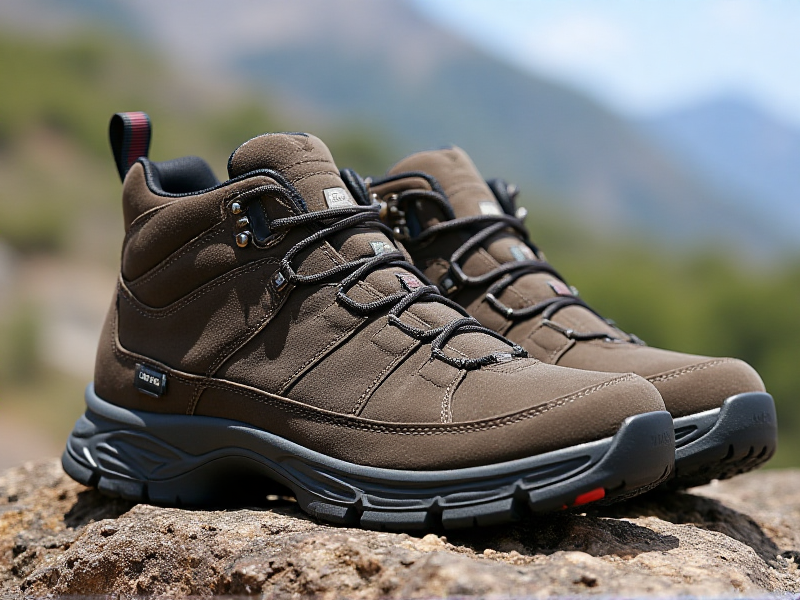Avoid Sore Feet & Blisters: Your 2024 Guide to Choosing Men's Hiking Shoes
2025-05-30

Here is an SEO-optimized article targeting "men's hiking shoes," written authentically and designed for web publishing:
Stepping onto the trail with confidence starts directly beneath your feet. The wrong footwear can turn a scenic hike into a painful slog filled with blisters, sore soles, and unstable footing. For men looking to conquer trails comfortably and safely, investing in the right pair of men's hiking shoes is non-negotiable. Forget making do with old sneakers; dedicated hiking footwear is engineered for the unique demands of uneven terrain, varying weather, and carrying a load.
Why Your Everyday Shoes Fall Short on the Trail
Standard trainers or boots lack the crucial features needed for hiking:
Insufficient Traction: Smooth soles slip dangerously on wet rocks, roots, or loose gravel.
Poor Ankle Support: Weak ankles are prone to rolls and sprains on rocky or uneven paths.
Inadequate Protection: Thin materials offer little defense against sharp rocks or roots.
Lack of Stability: Flexible midsoles can't maintain control on off-camber trails.
Zero Weather Resistance: Feet quickly become soaked in damp conditions.
Key Features to Look for in Men's Hiking Shoes
Choosing the best men's hiking shoes involves understanding crucial features:
1. Mid-Cut vs. Low-Cut: This is a primary decision. Low-cut shoes offer maximum lightness and agility, popular for day hikes and well-maintained trails. Mid-cut boots provide crucial ankle support, reducing strain and injury risk on uneven terrain, backpacking trips, or when carrying heavier loads.
2. Outsole & Traction: Look for aggressive, multi-directional lugs made from sticky rubber compounds (like Vibram Megagrip). Deeper lugs bite into soft ground, while shallower, widely spaced patterns shed mud better. The grip on wet rock is vital.
3. Midsole Cushioning: This absorbs shock, protecting your feet and knees during miles of travel. EVA foam is common, offering good cushioning. Some premium shoes incorporate PU foam or proprietary technologies (like Merrell's Air Cushion) for enhanced rebound or durability.
4. Upper Materials & Durability: Options abound:
Full-Grain Leather: Highly durable, weather-resistant, and supportive. Heavier and requires breaking in.
Suede/Nubuck Leather: Softer, lighter, and more flexible than full-grain. Less waterproof inherently. Often paired with synthetic overlays.
Synthetics (Mesh, Nylon, Polyester): Very lightweight, breathable, and quick-drying. Often feature protective overlays. Less durable than leather but requires minimal break-in. Most modern men's hiking shoes utilize synthetics.
5. Waterproofing (or Not):
Waterproof Membranes (GORE-TEX, eVent): Essential for wet climates, snow, stream crossings, or muddy trails. They block external moisture while theoretically allowing sweat vapor out. Can make feet feel warmer.
Non-Waterproof: Made from breathable mesh, these shoes offer superior ventilation, allowing sweat to escape quickly. Ideal for hot, dry climates and fast-paced hikes where wetness comes mainly from sweat. They drain and dry much faster if submerged.
6. Support & Fit: Your feet will swell during miles of hiking. Always try on hiking shoes with the socks you plan to hike in. Ensure your heel is locked down without slippage, your forefoot has ample room to spread without being pinched, and there's adequate volume (especially important for wider feet). Proper arch support is critical for preventing fatigue.
Choosing the Right Pair for YOUR Hike
Consider your primary terrain and activity level:
Day Hiking (Lightweight Trails): Low-cut or mid-cut trail runners/hiking shoes excel here, prioritizing agility and comfort. Breathable mesh uppers shine.
Backpacking/Rugged Terrain: Opt for sturdy mid-cut hiking boots. Prioritize ankle support, durable uppers, excellent traction, and sufficient cushioning under load. Waterproofing is often recommended. Full-grain leather or robust synthetic mixes work well.
Wet & Cold Conditions: Waterproof men's hiking shoes (or insulated versions for extreme cold) are essential. GORE-TEX and similar membranes keep feet dry from the elements.
Hot & Dry Climates: Prioritize ventilated, non-waterproof models. Lightweight mesh allows maximum airflow and fast drying.
Top Brands Putting Men on the Trail Right
Trusted manufacturers consistently deliver quality performance:
Salomon: Known for innovative constructions, superior grip (Contagrip), and great fit for narrower to medium feet.
Merrell: Offers excellent value and diverse options, especially popular Moab models known for comfort out of the box.
Vasque: Emphasizes durability and sturdy support, often using high-quality leathers.
Keen: Excellent for wider feet (especially in the toe box), durable, and often feature protective toe bumps.
Oboz: Focuses on aggressive traction, solid arch support, and sustainability. Famous for their B-Dry waterproof membrane.
La Sportiva: Highly technical footwear, favored by serious mountaineers and climbers requiring precision fit and grip.
HOKA ONE ONE: Known for maximalist cushioning, bringing incredible comfort and shock absorption to well-cushioned trail runners/hikers.
Caring for Your Investment: Making Your Hiking Shoes Last
Don't just toss them in the garage after a muddy hike! Proper care extends their life:
1. Clean Regularly: Brush off dried mud and dirt. For deeper cleaning, use a soft brush and mild soap (avoid harsh detergents). Remove insoles to dry separately.
2. Dry Properly: NEVER dry men's hiking shoes near direct heat sources (fireplace, radiator, dryer). Stuff them with crumpled newspaper and let them air dry at room temperature. Remove newspaper once damp and replace if needed.
3. Protect: Apply waterproofing conditioner (appropriate for the material – leather conditioner for leather, DWR spray for synthetics/mesh) periodically to maintain water resistance and suppleness.
4. Inspect: Check laces, eyelets, stitching, and the tread for wear and tear. Replace laces before they break on the trail.
Step Into Your Next Adventure
Choosing the right men's hiking shoes transforms your time on the trail. No more painful distractions – just the feeling of secure footing, reliable comfort, and the freedom to explore further. Consider your environment, terrain, and personal needs, prioritize proper fit above all else, and invest in quality footwear. Your feet are your vehicle on the trail; give them the dependable grip and protection they deserve. What incredible trail will your next pair help you conquer? Tell us!
Category: